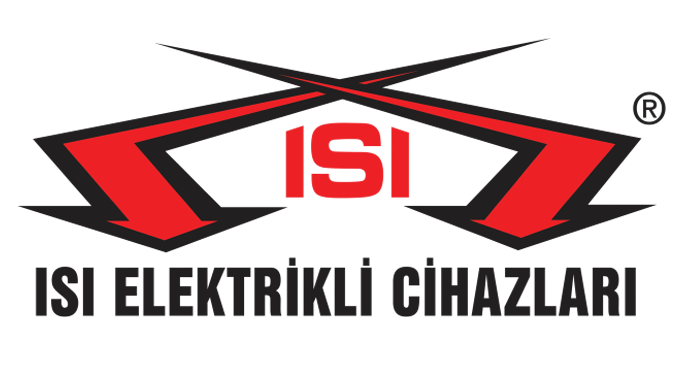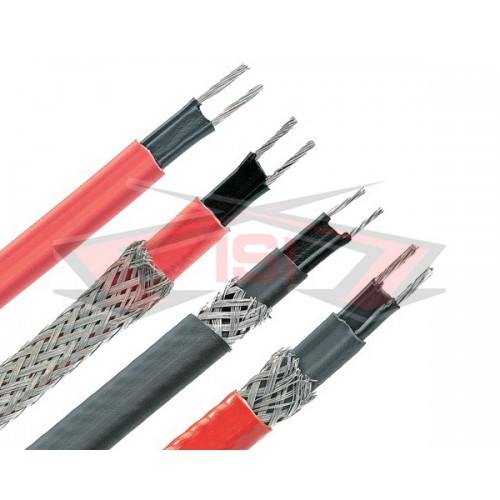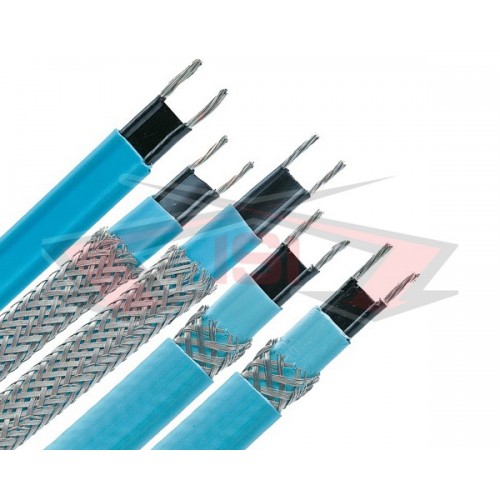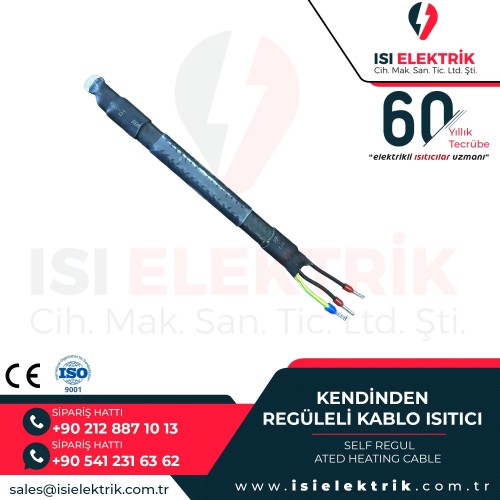Self Regulated Heating Cables
Self-Regulating Cable Heaters are types of heaters that provide the opportunity to be used in many areas to prevent freezing of the material passing through the pipe, in hot oil, hot water lines, fire extinguishing pipelines that require thermal tracing, outside the pipes with liquid or gas flow.They are highly preferred products in many areas in the industry, especially in cold climates, in the plumbing pipes of the houses. Its flexible structures are designed to be easily wrapped around the outside of the pipes to be used, and its ease of use is its greatest advantage.
The most important feature of self-regulating Cable Heaters is that they can be used without the need for thermostat or thermocouple control by regulating the surface temperature. Thanks to the semiconductor in its structure, while heating with a higher watt value in cold environments, it reduces the watt value as the ambient temperature gets warmer, providing both heat control and energy savings.
It provides a high level of occupational safety in dangerous environments by complying with Atex standards as certified in environments with explosive and dangerous gas content.
Our company offers these products to your service by providing both material supply and applied engineering services.For detailed information, please contact our company.
Self-Regulating Heaters
Self-regulating heaters are special types of resistors used in electrical circuits. These are electrical components that can automatically adjust or regulate their resistance within a certain temperature range. Thanks to these features, they are used in applications where they need to remain at a certain temperature or operate at a specific temperature.
Self-regulating heaters can be designed using components such as thermistors or resistance-heat sensors. These are made from materials sensitive to temperature changes. As the temperature increases or decreases, the resistance of these components changes, which affects the flow of electric current.
Self-regulating heaters are commonly used in many industrial applications. For example, they can be encountered in automatic heating systems, temperature control devices, thermal protection circuits, and ovens. These resistors are used to maintain the temperature in the system within the desired range, ensuring the safe and efficient operation of the systems.
Working Principle of Self-Regulating Heaters
Self-regulating heaters contain a matrix made of a special semiconductor polymer material that automatically adjusts its resistance based on temperature changes. This feature prevents excessive energy consumption while ensuring that the target surface does not overheat.
1. Temperature-Dependent Resistance Change: As the temperature increases, the resistance of the self-regulating heater rises, limiting the current flow. This means that when the ambient temperature rises, the heating power is automatically reduced. Conversely, when the ambient temperature drops, the resistance decreases, allowing more heat to be generated to maintain the desired temperature.
2. Energy Efficiency: Unlike traditional fixed-power heaters, self-regulating heaters consume only as much energy as needed. This leads to significant energy savings and reduces operating costs.
3. Overheat Protection: Self-regulating heaters automatically limit their heat output when a certain temperature is reached, eliminating the risk of overheating. This allows for safe operation without requiring additional temperature sensors or control systems.
4. Application Areas: These heaters are commonly used in pipeline systems, storage tanks, water installations, and industrial heating applications. They are also ideal for preventing pipes from freezing in cold weather conditions.
5. Long Lifespan and Durability: Manufactured with high-quality materials, self-regulating heaters are designed for long-term use. They are resistant to chemicals, corrosive substances, and harsh environmental conditions, making them a reliable solution for demanding applications.
In conclusion, self-regulating heaters provide an intelligent heating solution that ensures energy efficiency, safety, and reliability. Widely used in industrial and commercial applications, this technology helps systems operate more efficiently and securely.
Technical Specifications of Self-Regulating Heaters
- Temperature Resistance: Available in variants that can withstand temperatures ranging from -50°C to 200°C. High-temperature resistant models offer long-lasting performance in industrial applications and maintain stability under extreme temperature fluctuations.
- Power: Power options range from 10 W/m to 60 W/m. Depending on the application, different power levels can be selected. Lower watt options are ideal for delicate areas requiring minimal power consumption, while higher power models are used in applications demanding greater heat output.
- Voltage: Available in multiple voltage options such as 12V, 24V, 110V, and 220V. Low-voltage models are ideal for small-scale or mobile applications, while higher voltage versions are commonly used in industrial-scale heating systems.
- Resistance: Resistance varies according to temperature. As the ambient temperature rises, the resistance increases, reducing energy consumption; when the temperature drops, the resistance decreases, allowing more heat production. This feature ensures energy efficiency and prevents unnecessary power wastage.
- Heating Cable or Band Length: Can be produced in various lengths to suit the application area. From short-distance pipe heating applications to large-scale surface heating systems, custom length production is possible.
- Outer Sheath: Made with protective materials such as PVC and nylon to resist wear and tear. Designed to withstand external environmental conditions, these heaters provide protection against water, chemicals, and mechanical damage for long-term use.
- Chemical Resistance: Certain self-regulating heater models are designed with coatings resistant to chemicals. This makes them suitable for environments exposed to acids, bases, oils, and other industrial chemicals.
- Flexibility: Their bendable structure allows easy application to pipes or surfaces, ensuring simple installation even in tight spaces.
- Safety Features: The self-regulating design prevents overheating, ensuring safe operation. It automatically adjusts the temperature without the need for an additional thermostat, reducing fire hazards and enhancing safety.
Applications of Self-Regulating Heaters
- Heating Systems: Self-regulating heaters are used in a wide range of heating applications, from water heaters in homes to industrial heating systems. These heaters can heat water or air within the desired temperature range, providing consistent heating.
- Automotive Industry: In the automotive industry, self-regulating heaters are used in vehicle interior heating systems, seat heaters, and vehicle engine cooling systems. These heaters are important for controlling the temperature inside the vehicle or maintaining the engine within a certain temperature range.
- Food Industry: In the food industry, self-regulating heaters are used in ovens, grills, heating lamps, and other food processing equipment. These heaters ensure that foods are cooked or kept warm at a specific temperature.
- Medical Applications: Self-regulating heaters are frequently used in medical devices, laboratory equipment, and other medical applications. These heaters provide precise temperature control within specific temperature ranges, ensuring the safe and effective operation of medical equipment.
- Electronic and Electrical Devices: Many electronic and electrical devices contain self-regulating heaters. These devices include heating pads, temperature control devices, thermal printers, and many others.
- Industrial Processes: In industrial production processes, self-regulating heaters are used in many applications ranging from chemical reactors to plastic processing machines. These heaters ensure process stability within specific temperature ranges and improve product quality.
Advantages of Self-Regulating Heaters
- Automatic Temperature Control: Self-regulating heaters are sensitive to temperature changes through their thermistors or resistance-heat sensors. Thus, they can automatically adjust their resistance within a specific temperature range to maintain a constant desired temperature.
- Energy Efficiency: Self-regulating heaters adjust the amount of current and thus energy consumption based on temperature changes in the system. This feature leads to energy savings and prevents unnecessary energy loss.
- Enhanced Safety: Self-regulating heaters can provide self-protection in case of overheating. Thermistors or resistance-heat sensors increase system safety by altering resistance at excessive temperatures.
- Low Maintenance Requirements: Self-regulating heaters generally have a simple and durable structure, offering long-term and reliable performance with low maintenance needs.
- Various Application Areas: Self-regulating heaters have a wide range of applications in different industrial and commercial settings. They are commonly used in heating systems, temperature control devices, thermal protection circuits, and more.
- High Precision and Control: Self-regulating heaters can respond very sensitively to temperature changes, making them preferred for applications requiring precise temperature control.
Considerations When Choosing Self-Regulating Heaters
- Application Area: It's important to determine where the heater will be used and for what purpose to select the appropriate type of heater.
- Temperature Range: The operating temperature range of the heater should meet the application requirements, considering operating temperatures and maximum temperature fluctuations.
- Power and Voltage: Determining the required power and voltage levels is crucial for achieving the desired heating performance.
- Length and Size: The length and size of the heater should be suitable for the intended application area and mounting requirements to ensure efficient operation.
- Resistance Variation: Understanding the resistance variation characteristics of self-regulating heaters is important to determine how they respond to temperature changes.
- Protection Features: The heater should have protection features against overheating, short circuits, and other safety risks to ensure safety.
- Durability and Material Quality: The material and durability of the heater are important for long-term use. It's preferable to choose heaters made of quality materials that can maintain durability over time.
Features of Self-Regulating Heaters Providing High Thermal Efficiency
Self-regulating heaters utilize advanced heating technology to ensure high energy efficiency. Their temperature-sensitive structure prevents unnecessary energy consumption while maintaining optimal heating levels. Thanks to these features, they are widely used in industrial facilities as well as residential applications.
- Automatic Power Adjustment: The heater automatically adjusts its power output based on the operating temperature. When the ambient temperature rises, power consumption decreases, preventing overheating while saving energy.
- Energy Efficiency: Compared to traditional heating systems, self-regulating heaters use only the necessary amount of energy. This prevents excessive electricity consumption and reduces operating costs.
- Long Lifespan and Durability: Minimizes overheating issues, extending the lifespan of components. It operates efficiently for long periods without the need for frequent maintenance.
- Advanced Heat Distribution: Distributes heat evenly, minimizing temperature variations. This ensures more balanced and effective heating.
- Eco-Friendly Solution: Lower energy consumption helps reduce the carbon footprint. It is an ideal heating solution for businesses with a strong environmental awareness.
- Safe Operation: Prevents overheating, significantly reducing the risk of fire. It automatically regulates temperature without requiring an external thermostat, ensuring a safe working environment.
- Wide Range of Applications: Can be effectively used in industrial pipeline systems, tank heating systems, and outdoor surface heating solutions.
Self-regulating heaters provide maximum performance while ensuring energy savings through their advanced technology. With high efficiency and enhanced safety features, they are among the most ideal modern heating solutions.
Energy Savings with Self-Regulating Heaters
Self-regulating heaters are smart heating elements that can adjust their resistance based on temperature changes. This prevents unnecessary energy consumption and ensures high efficiency.
How Self-Regulating Heaters Work
These heaters contain special conductive materials based on thermoplastics or polymers. As they heat up, their resistance increases, reducing current flow and preventing overheating. This results in energy savings.
Energy-Saving Benefits
- Reduces unnecessary energy consumption.
- Eliminates the need for manual temperature control.
- Has a longer lifespan and requires minimal maintenance.
- Prevents overheating, enhancing safety.
Applications
These heaters are widely used in industrial pipelines, water installations, ventilation systems, laboratory equipment, and food production.
Self-regulating heaters combine smart heating technology with energy efficiency and safety, providing sustainable solutions. Therefore, they are an ideal choice for businesses looking to improve energy efficiency.
Frequently Asked Questions
Self Regulated Heating Cables



